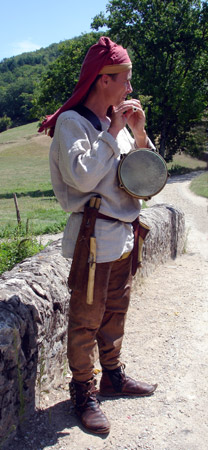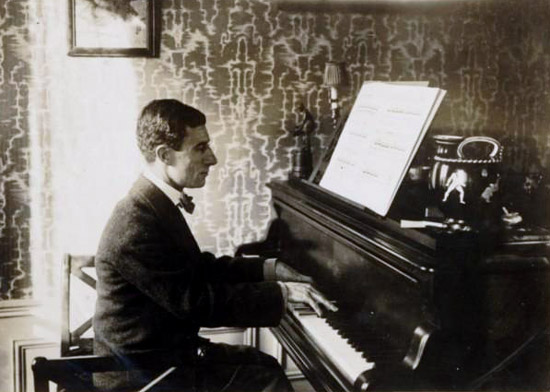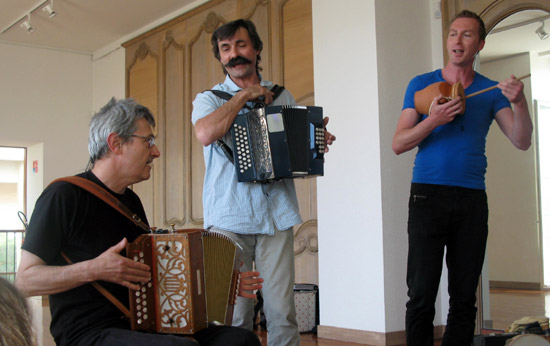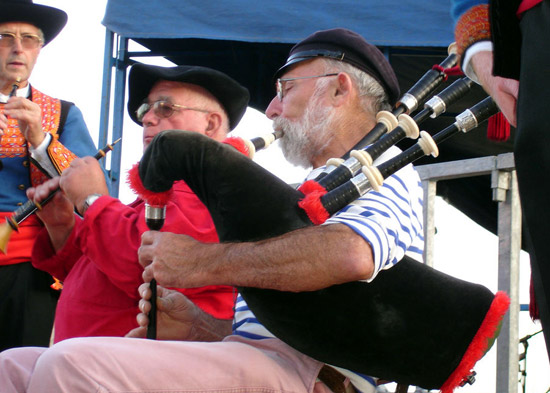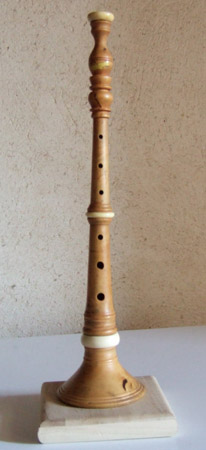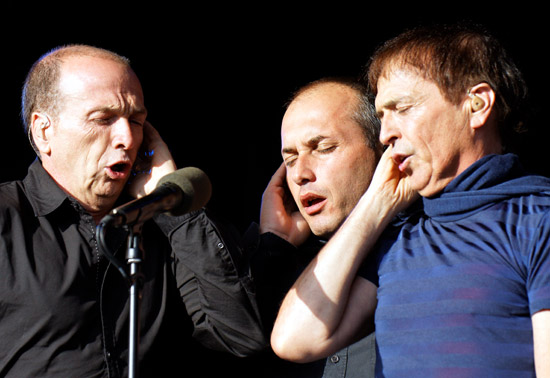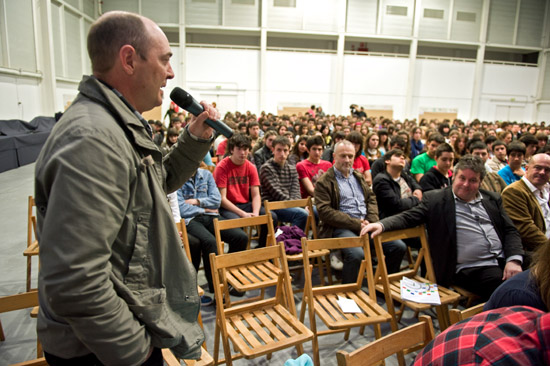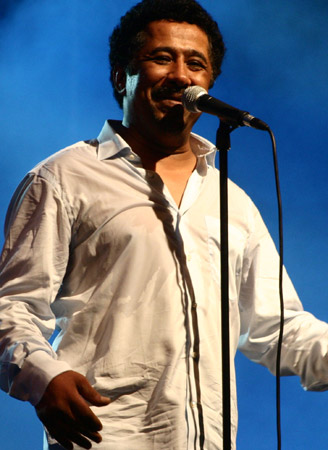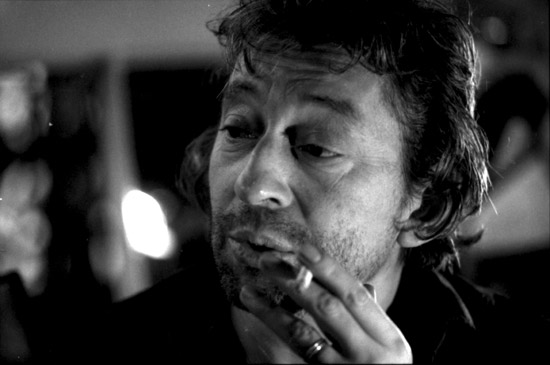Music: Traditional Forms
Early Music
French musical innovations changed the course of European music in the Middle Ages. The Ars Nova developed polyphonic singing out of Gregorian plainsong, with the organum (part singing) of Pérotin and his followers, culminating in the magnificent complex polyphony of Guillaume de Machaut.
In the Occitan-speaking south, poets and singers were elaborating poetic forms that would affect all of Europe, both the folk tradition and learned music and literature. The troubadours invented an ideal of courtly love and proceeded to write immensely popular poems and songs about it. Many troubadour song tunes have been preserved. The trouvères were northern French poets and musicians who adapted the songs of the troubadours and composed works in the same style.
The popular image of a troubadour as a man in tights with a lute on his back, singing for his supper, is actually a better fit for the jongleurs (jugglers) and ménestrels (wandering folk musicians) of the Middle Ages. The troubadours, on the other hand, were court musicians, and would have looked down on the ménestrals as mere buskers. Still, the music heard by the majority of medieval Frenchmen would have come from the wandering fiddlers, pipers, and singers, not the refined musicians of the courts. The ménestrals sang about heroes and battles, in a form known as the chanson de geste, the best-known example being La Chanson de Roland, an epic poem telling of a heroic stand against Moorish invaders in the time of Charlemagne.
Music of Court and Concert Hall
Throughout musical history, French composers have periodically taken center stage and changed the course of art music. In the 17th century, Jean Baptiste Lully pioneered opera and built the foundations on which later composers would erect the symphony. In the early 18th century, Francois Couperin wrote keyboard music of quiet genius. No world-dominating composer emerged from France again until Hector Berlioz produced his gigantic symphonies in the mid-19th century. Claude Debussy’s life and works began in the mid-19th century and reached into the early 20th, but his compositional innovations still influence composers. Maurice Ravel and Erik Satie have also had a long-lasting influence on music. Satie’s piano pieces, and above all his witty avoidance of convention, had a major effect on composers in the mid-20th century (especially in America).
France continues to produce composers like Satie who are sui generis and seem to come out of nowhere. Though in his early compositions Olivier Messiaen explored the serialist orthodoxy of his time, his strongly individual musical imagination eventually produced works of a beauty all his own. Pierre Boulez’s rigorous composition sets a high standard for modernist French music. The Spectralists are a contemporary development that combines the analytical rigor of the serialists with Messaien’s strange harmonies and love of beautiful sounds. Two important composers of this tendency are Tristan Murain and Gerard Grisey.
Regional and Ethnic Forms
Paris
Paris is its own musical region. Several forms of urban folk music were born there, and it continues to be a mixing pot for musics from around the world.
In the late 19th century, many people from the Auvergne region in southern France relocated to Paris. They brought their music with them, vigorous folk dances like the bouree, played on a kind of bellows-blown bagpipe called the cabrette and on the hurdy-gurdy, called vielle by the Auvergnats. In Paris they held dances called bal-musettes (bagpipe balls) which developed its own genre of music.
At the turn of the 20th century, many Italians settled in Paris, cheek by jowl with les Auvergnats. The Italians brought their own music and dances; they favored the accordion. Soon the two groups were attending each other’s dances and playing each other’s music. Out of this mix an accordion-based urban dance music developed. Italian dance tunes and opera arias, Spanish dances, and southern French folk dance mixed with café songs and popular dance orchestras. This became the bal-musette.
A young banjo player in various bal-musette groups would later take up the guitar and American jazz, mixing it with Gypsy music and bal-musette to create the unique French style of le jazz hot (also known as jazz manouche—Gypsy jazz). Django Reinhardt, along with violinist Stephane Grappelli, created one of the rare jazz offshoots as potent and influential as the original. Their music continued to evolve, and is still being elaborated by the jazz manouche musicians of today.
Occitania
Occitania spreads across the South of France and into parts of Spain and Italy. The music of the medieval troubadours still echoes in the songs and dance tunes of the region. Many of the early musical ensembles of the folk revival in the 1970s came out of Occitania, such as Lo Jai and La Bamboche.
Occitania itself has subregions, each with its own dialect and musical culture. From the Gascon lands in the west, through Berry and the center of France, to Mediterranean Provence and the mountains of Auvergne and transalpine Occitania, bagpipes, hurdy gurdies, accordions, and songs in the langue d’Òc make up a rich musical bouillabaisse.
Breiz Uhel, Breiz Izel
Brittany (Breiz in Breton) is a country within a country. Some quarter-million Bretons in the western half of the country still speak the Breton language. Endless wars with the Franks saw Breton kings extend their rule as far as Le Mans in the east, and be driven back as far as Vannes in the west. The fought-over land became Upper Brittany, where Bretons speak Gallo, a dialect of French. Both halves of Brittany have distinctive traditions of folk song and dance music.
The Bretons have a strong sense of national identity, and Breton music has been an important part of the recovery of cultural independence. In the 1890s there were hundreds of biniou and bombarde players in the countryside. By the time World War II ended, there were only a dozen. Folk music collectors recorded the repertoire and techniques of the older pipers, and also introduced the Scottish Great Highland bagpipe, slightly retuned to suit Breton music, organizing pipe bands on the Scottish model, but playing Breton tunes, and incorporating the bombarde. This activity served both to preserve and to promote traditional music. Local folk music clubs also contributed, organizing dances and singing festivals, and collecting songs and tunes from older people.
Today the efforts of these early collectors and musicians have been successful, and there are again hundreds of biniou and bombarde players, as well as singers of gwerz (the ancient Breton ballads), dancers, accordion players, fiddlers, flutists, and electric guitar players, playing Breton dance music.
Prior to the 18th century, the only instruments played for dance in Brittany were the biniou and bombarde, which are always played together: as a Breton piper put it, “the biniou and bombarde are one instrument that it takes two people to play.” A distinctive feature of the music is the interplay of the bombarde and the higher-voiced biniou. The bombarde will drop out for several bars of music while the biniou continues to play. The bombarde then rejoins the piper, sometimes in the middle of a phrase—the back and forth exchange gives energy and variety to the music.
This turn-taking also duplicates the call-and-response singing of kan ha diskan, the Breton style of singing for dancing, in which the singers take turns leading the song, sharing only the final notes of a phrase.
In the 18th century the vielle a roue began to be more widely played in Brittany, especially on the north coast. Some scholars point to the end of an aristocratic fad for the instrument, which resulted in many well-made vielles suddenly coming on the market. Whatever the reason, it became a very popular instrument.
The clarinet was spread in Brittany by military bands. Traditional dance musicians soon adapted it. They had their own names for the instrument, the most common being the treujenn gaol (cabbage stump). The clarinet was often played together with the accordion, another recent introduction, or the vielle a roue.
There are old photographs of the violin being played by dance musicians in the western part of Brittany during the 19th century, but the only fiddle tradition that lasted into the 20th century was in the eastern, Gallo part of the country. Today young fiddlers have kept the music of the old Gallo fiddlers alive, and adapted the biniou and bombarde repertoire, inventing a Breton fiddle style.
Another instrument not often found before the folk music revival is the wooden flute. Breton musicians have long been fascinated by Irish music, and flute players like Jean Michel Veillon (a member of Kornog and many other bands) began to adapt the instrument to Breton music. Today there are numerous players, and the wooden flute has become a Breton instrument.
In the Middle Ages the Breton bards were famed for their harp playing and singing of Arthurian lays. Traditional harps did not survive the centuries, and there is no record of how the old harpers played. But Breton musicians have tried to reimagine a Breton harp music, looking to the harp playing in Ireland and Scotland, where the tradition was (barely!) continuous, along with research into medieval music, and a deep knowledge of Breton dance music. Alan Stivell, son of a harper, is perhaps the best known and most successful of the revivalist Breton harpers. A piper, singer, and songwriter as well as harper, he brought Breton music to an international audience, and helped pioneer the combination of traditional music with rock-and-roll instruments and rhythms.
Breton folk dances such as an dro, jabadao, gavotte, and dans plinn are round dances and chain dances. Danced to biniou and bombarde or to kan ha diskan singing of old ballads, Breton dances represent the oldest strata of European folk dance. In the Gallo part of the country, there is a couple-dance repertoire similar to that in the neighboring French province. The rondes paludiers, or round dances of the salt gatherers, are found only in the southeastern corner of Brittany.
Festoù-noz (night parties) and festivals such as the enormous music festival at Lorient, where music from all the Celtic countries is heard, are the main public venues for traditional music and dance in Brittany. They help keep Breton traditional music a living presence.
Amplified bands such as Sonerion Du, combining traditional instruments like the bombarde and accordion with electric guitars and drums, developed at the festoù-noz, and are now an important part of the Breton music scene. Musicians have yoked traditional Breton sounds to everything from African music, jazz, and classical music to punk rock.
Corsica
Corsica is a French island where they speak Italian (though the Corsicans insist that Corsu is its own distinct language). A rocky, difficult terrain, until recently it was mostly known as the birthplace of Napoleon Bonaparte.
Now however it is the distinctive polyphony of the small Corsican choirs that symbolize Corsica to many. These groups (mostly all male, though a few all-female choirs have been organized) sing spare, deep-voiced songs from the Corsican folk tradition in three-part harmony. The vocal quality is “straight,” that is, without the vibrato used by classically trained singers. This gives the polyphony an unusual clarity. Most surprising are the harmonies, which occasionally fall into a jarring dissonance, unsettling the first time you hear it, but compelling and addictive.
Some of the varieties of Corsican choral singing are paghjella (secular songs, sung in trios), tribierre (threshing songs); chjam' è rispondi (call-and-response singing), and cuntrastu (choirs of male and female voices). Besides pulifunie (polyphony) there are voceri, (solo folk songs), lamentu (laments, secular or sacred; often sung at funerals), and nanne (lullabies). Hearing deep, clear powerful Corsican voices performing these ancient tunes is like hearing iron sing, voices from deep underground. One song collector and performer called it “song from the beginning of the world.”
Corsican singing is most often unaccompanied, but there is also an instrumental tradition, both as song accompaniment and to provide dance music. Typical Corsican instruments are the cetara (a cittern-like instrument), the mandulina (mandolin); the viulinu (violin); the caramusa (a small bagpipe); the cialamedda (a double-reed shawm), and the urgunetta, a button accordion.
Corsicans who were not fishermen tended to be shepherds, and typical shepherd’s instruments are still played. The pirula is a small fipple flute, like a tin whistle. The pifana is a high-pitched fife made from a goat horn; sunaglieri (mule bells) and timpanu (triangle) provide rhythmic accents. The tromba is a rolled-bark reed pipe; the zampugna is a single-reed hornpipe made from an animal horn.
The quadrille and cuntradans danced in Corsica seem to belong to a pan-European dance repertoire. Also danced are the possibly older caracolu, the moresca, which is supposed to depict Moors and Christians fighting and may date from the Crusades, and the granitula, a religious processional that follows the course of a spiral.
French Catalonia
The Catalan language is closely related to Occitan, and parts of ancient Catalonia are now within the political borders of France. Here they dance the sardana, an ancient round dance, repopularized in the 19th century as part of the Catalan recovery of national identity. The connection was a powerful one, apparently, because the dance was forbidden under dictator Francisco Franco. Now legal once more, it continues to be popular. The sardana is danced to a Catalan band, called a cobla. Unique to the Catalan cobla are the tenora, tiple, and gralla, folk shawms updated for playing in a modern dance band.
The Roma
Django Reinhardt is far from the only Gypsy in French music. In the southern French city of Perpignan there has been a large Roma community for at least a hundred years. Another group of Roma live not far away in Provence’s Camargue region. They have kept alive Roma musical traditions, but have added a heady mixture of the French and world musics they hear around them. Out of this a dance music called rumba catalane has developed. The music group the Gypsy Kings, from the Camargue region, had a big hit with a recording by that title, and are now bringing Roma rumba to an international audience.
Basque Country
The Basques form their own nation, Euskal Herria, spread across the border of France and Spain. A very ancient people, quite possibly the original inhabitants of Europe, the Basques have managed to hang on to their language, unrelated to any tongue spoken today (though one Russian linguist saw links to American Indian languages), and a distinctive music.
A unique form of verbal art, bertsolaritza involves the singing (to strictly defined melodic formulae) of improvised rhymed poetry, obeying definite and restrictive rules. Bertsola are made up by the singer on the spot, under the eye of his or her audience. Bertsolaritza are wildly popular in Basque country; competitions between bertsolari can fill stadiums and attract more than 20,000 spectators at a time (in a country of less than 3 million).
Choral music is popular, with many choirs in the major cities. Basque folk music makes up most of the repertoire, though some music has been written especially for the choirs. Breaking off from the big choirs are the ochotes, groups of eight deep-voiced male singers.
The Basques share some ancient musical instruments with the rest of Europe, and have a few found nowhere else. The alboka is a hornpipe—that is, a reed pipe with cowhorn bells at either end. It is played like hornpipes elsewhere, with a circular breathing technique, so that the sound is uninterrupted. The txistu is a three-holed pipe played by overblowing; txistu players simultaneously play a small drum, the tambour.
The trikitixa is a button accordion with keyboard layout and left-hand bass patterns unique to Basque players. Basque dance tunes like the fandango are played in a rapid, highly ornamented style. The popular trikitixa player Kepa Junkera has introduced Basque-style accordion playing to a wider audience. The ttun-ttun is a stringed percussion instrument, known as the tambour de Bearn in the south of France. It is often played to accompany the txistu. The dulzaina and txanbela are large and small shawms, double-reed instruments like the Catalan graile, or Breton bombarde. The kirikoketa developed out of the rhythmic work of crushing cider apples. The large mallets used for this are struck against large timbers, making a rhythmic percussive sound. The txalaparta is a series of three to five wooden beams struck with short, stout sticks. The sound is something like a big marimba, although rhythm is emphasized more than melody. Like the kirikoketa, the txalaparta is associated with the making and drinking of cider.
Article written for World Trade Press by Marc Lecard.
Copyright © 1993—2025 World Trade Press. All rights reserved.

 France
France 